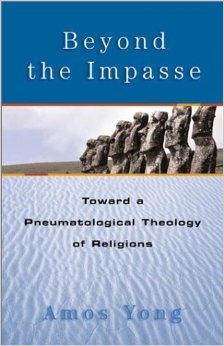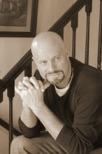“Beyond the Impasse” by Amos Yong
 In an increasingly globalized context, the challenge of a pluralistic environment regarding religion is a fact on the ground for most of us in the United States. How does our theological reflection engage this environment? Amos Yong comes alongside us in this journey in his seminal work Beyond the Impasse: Toward a Pneumatological Theology of Religions. He provokes us to seriously consider: if the Spirit is indeed active throughout the world, how indeed might we discern the Spirit’s activity in other non-Christian religious contexts and traditions? What is the Father up to, if anything, in other religious contexts? This may be more beyond-the-pale for some of my friends, but for me Beyond the Impasse, since its publication in 2003, remains on the cutting edge of a Christian orientation toward interfaith dialogue and an engagement with our very present context of pluralism.
In an increasingly globalized context, the challenge of a pluralistic environment regarding religion is a fact on the ground for most of us in the United States. How does our theological reflection engage this environment? Amos Yong comes alongside us in this journey in his seminal work Beyond the Impasse: Toward a Pneumatological Theology of Religions. He provokes us to seriously consider: if the Spirit is indeed active throughout the world, how indeed might we discern the Spirit’s activity in other non-Christian religious contexts and traditions? What is the Father up to, if anything, in other religious contexts? This may be more beyond-the-pale for some of my friends, but for me Beyond the Impasse, since its publication in 2003, remains on the cutting edge of a Christian orientation toward interfaith dialogue and an engagement with our very present context of pluralism.
Beyond his academic prowess and his keenly informed pentecostal perspective, perhaps Professor Yong is uniquely qualified to forge the way ahead in this area. He spent his early years living in Malaysia – a country of Islam-centered dominance in its power structures, yet still a deeply multicultural and multi-confessional environment – with his family of Chinese heritage – who passed along to him Confucian values embedded in a Christian approach to faith – before emigrating to the United States.
While adopting Paul Tillich’s definition of religion, why a pneumatological theology of religions? What is at-issue with the prevalent christological thrust? It seems Yong believes that our christological theology of religions has limited our dialogue and theological reflection to soteriological categories and conversations along the faultlines of inclusivism and exclusivism. He envisions a pneumatological paradigm as a breakthrough that transcends the limited dialogical and practical engagement that we have had in the past, in order to swim in deeper, more discerning waters. Acknowledging ahead of time that this point – an ‘either/or’ between an initial christological thrust and an initial pneumatological thrust – is a primary subject that must be explored on this journey, and, in fact, this is exactly the crux of the matter that Yong wades into early in the book. Most of the time this kind of structure to a book inhibits my progression. Seeking to answer objections before you have made your case with some clarity, can be disastrous in bringing those along with you who are willing to journey and read with you in the first place. Alas, for what has been and will continue to be so controversial about this kind of theological reflection, I suppose it necessary to be very deliberate to bring as many along on this journey as possible, and Yong is up to the invitational task with biblical and theological acumen. He bravely forges a way beyond the ‘either/or’ and into the ‘both/and’ of theological explorations of new ways of looking at old questions.
His ‘both/and’ point of reference – pneumatology – cuts not against the grain of christology, but along a wholly other bearing that engenders new outlook for dialogue and understanding but equally embraces a heightened acquaintance with our own Trinitarian provenance. At the heart of this engagement, is that pneumatology provides us with the best relational framework to engage this endeavor of Christian theology, after all, as Yong himself says in the introduction, “theologizing about the religions requires engaging them.” (p. 21) Explaining further, he points out that, “[g]enuine dialogue proclaims truth, and effective proclamation engages others at an interpersonal level…[a] pneumatological approach to the non-Christian faiths supports and encourages…and…opens up the Christian to whatever is true, good, beautiful and holy in the other tradition, even while nurturing an environment in which the non-Christian can come to appreciate the same in the Christian faith. What else is this besides grassroots evangelism?…My point is that a pneumatological theologia religionum is always in via…always in quest, open to further investigation by continuously enlarging the borders of inquiry.” (p. 54) This sort of theological reflection from a relational perspective may resonate with many in the Vineyard who have followed the journey of one of our most beloved missionaries, Carl Madearis.
The next section was a struggle for me, as Yong engages with philosophical theology regarding religions and the metaphysics of Donald Gelpi’s trinitarian theology. Gelpi develops an incultrated theology in dialogue with the North American philosophic traditions of C.S. Pierce and the neo-Thomists Rahner and Lonergan. From Gelpi’s seed, Yong makes his initial move toward what he calls ‘foundational pneumatology’. For someone with more of a practical and biblical theology orientation, too much of the discussion devolved into a lot of ‘labeling’ and argumentation between ‘-ism’s’. But given the nature of Yong’s orientation, this initial interaction with philosophical theology makes room for a pneumatological imaginary – cultivated by a “life in the Spirit” – for the reader to springboard into the next sections that begin a tour of the theology of religions from different Christian traditions.
While touching on the theology of religions in other Christian traditions (Orthodox, Catholic, Protestant) – in which the main thrust of Yong’s contention is that the church in the West needs to reject the Filioque “which was an intrusion into the creed outside the recognized conciliar process” (p. 186), so that we can proceed with a pneumatological approach to the theology of religions, for this approach may “allow for more neutral categories to emerge when attempting to discern the presence and activity of the Spirit in other traditions” (p.186).
By far, though, his most sustained engagement – and certainly one of the most enriching – is with our quiet Canadian evangelical, Clark Pinnock. The depth of interaction with Pinnock was very encouraging, with encouragement at one point and critique the next, wrestling with the question: is it possible to assert the omnipresent of the Spirit and yet deny that the Spirit is at work only in socio-economic or political aspects of humanity and not in the religious aspect?
After mining for some strands in biblical, philosophic, theological perspectives, Yong comes to the heart of his own contribution within a pneumatological theology of religions: discernment. The Spirit-inspired dynamic modality of discernment is his suggested way forward to engage other religions. Yong suggests, “…discernment includes, in its broadest sense, perceptive attention to the wide range of natural, personal and social phenomena we encounter and, in its narrower sense, similar attention focused specifically on distinguishing between the divine, the human and the demonic.” (p. 157) This well-conceived strategy is organized by Yong into a move contra gnostic tendencies toward a more holistic approach that necessitates discernment of outer and inner dynamics, because, “…I can make no sense of the claim that the discernment of spirits is a purely spiritual exercise. Spirits are manifest in concrete forms, and the discernment of spirits requires attention to the variegated forms they take.” (p. 157) Yong goes even further to suggest that it is this tangibility of the demonic that enables a holistic understanding of spiritual warfare to emerge within our engagement with religions, one that includes the spiritual, social and economic works claimed by Jesus himself in Luke 4 would be the hallmarks of his ministry of the Kingdom.
Professor Yong ends with call for discernment and a hermeneutics of not only Life, but of the Religions. In our increasingly pluralistic context, this book will appeal to pastors, students, and everyone interested in an engagement with their neighbors who may be part of an Islamic mosque, a Hindu temple or a Buddhist meditation circle. Those within the Vineyard movement, and throughout the entire Church, who approach faith via a centered-set modality will find this work very intriguing. Yong does indeed do what he set out to accomplish: chart a path forward for a pneumatological theology of religions. For the brave pioneers who gravitate to the fault line of the gospel Beyond the Impasse is vital reading, following the Spirit, “…who blows wherever it pleases. You can hear its sound, but you cannot tell where it comes from or where it is going,” (John 3:8)…even into the deeply pluralistic landscape that is shaping our North American context.
 Reviewed by Steven L. Hamilton
Reviewed by Steven L. Hamilton
After studying Biblical Wisdom at the Baltimore Hebrew University, Steven Hamilton continues to engage the spirituality of wisdom and discernment through spiritual direction after instruction at the Sustainable Faith School of Spiritual Direction, the first school of its kind within the Vineyard community of churches. He currently lives with his beautiful wife, three lovely daughters and his dog in Maryland.
Tags: Amos Yong, Holy Spirit, Pneumatology, Religion, Steve L. Hamilton, Systematic Theology, World Religions

Connect
Connect with us on the following social media platforms.